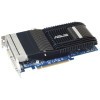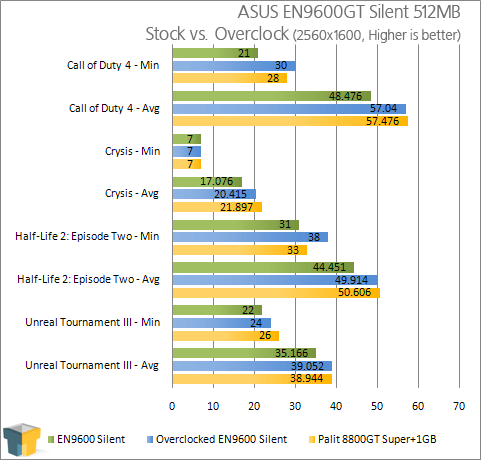- Qualcomm Launches Snapdragon 4 Gen 2 Mobile Platform
- AMD Launches Ryzen PRO 7000 Series Mobile & Desktop Platform
- Intel Launches Sleek Single-Slot Arc Pro A60 Workstation Graphics Card
- NVIDIA Announces Latest Ada Lovelace Additions: GeForce RTX 4060 Ti & RTX 4060
- Maxon Redshift With AMD Radeon GPU Rendering Support Now Available
ASUS EN9600GT Silent 512MB

Looking for excellent gaming performance but also want to keep PC noise to a minimum? The EN9600GT Silent from ASUS is the card to buy. It couples the power of the 9600 GT with pure silence, and costs little more than the stock model, making it a great choice for either the HTPC or desktop.
Page 12 – Overclocking the ASUS EN9600GT Silent
Defining a “Stable Overclock”
If you’ve read any of my processor reviews, you are probably aware that I don’t much care for an unstable overclock. As far as I am concerned, a high overclock is only good if it’s stable, because realistically, no one purchases a new GPU for the sake of only finding the maximum overclock. That is why I focus on finding the max stable overclock, rather than an overclock that can barely pass a benchmark run.
To find a max stable overclock, I first find an overclock that I believe could be stable. Once I do that, I’ll run a single loop of 3DMark 2006 to test for stability and to look for artifacts. If that run passes successfully, I’ll jump into a game quickly to see if the same results are exhibited in real-world gameplay. If that proves successful, I then run a loop of 3DMark 2006 for 4 – 8 hours at 2560×1600 2xAA to stress the card to its limit.
If after that point, the card is deemed stable (as in, no crashes occurred and there are still no artifacts), then I will proceed with benchmarking four select titles again: Call of Duty 4, Crysis, Half-Life 2: Episode Two and also Unreal Tournament III.
All overclocked testing occurs at 2560×1600 for the simple fact that it’s such a strenuous resolution. For comparisons sake, I also include results from a card that’s a step up from our overclocked model.
ASUS’ EN9600GT SILENT
The stock clocks for a 9600 GT are 650MHz Clock, 1625MHz Shaders and 900MHz Memory. On our previous 9600 GT reviews, we’ve managed to hit upwards of 785MHz Core, 1962MHz Shaders and 1100MHz Memory, however here, we didn’t get quite that high. My final overclock settles at 750MHz Core, 1925MHz Shaders and 1000MHz Memory.
While not a record 9600 GT overclock, it’s still impressive given that no fan is used whatsoever. That in itself is what sell this card. Having a good overclocking ability is just a bonus. But does our overclock do any good?

Yes, no question. In all of our tests, our overclocked card kept right up to the 8800 GT… not bad for a card that costs at least $45 less. Oh and did I mention, this card is silent? I’m finding it difficult to come up with a reason to complain about this card.
Overclocking Note: The world of overclocking is an unfair one, in that one persons max overclock might be much lower than another. Chances are good that you could reach the same overclock we did here, but of course, different computers can, and will, deliver differing results. Lots of factors can come into play, so please don’t be upset if you are unable to attain the same overclock we did.
Support our efforts! With ad revenue at an all-time low for written websites, we're relying more than ever on reader support to help us continue putting so much effort into this type of content. You can support us by becoming a Patron, or by using our Amazon shopping affiliate links listed through our articles. Thanks for your support!





